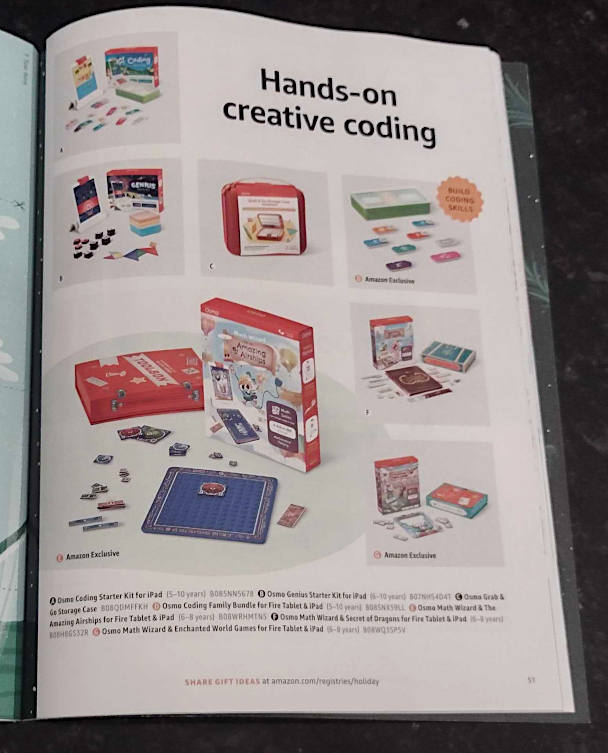The theme this year is Holiday Dash

For the past few years, Amazon has been mailing out a printed toy catalog for the holiday season. For those that know about it, it is often highly sought after.
It is the must have wish list of the season and is full of lots of fun activities for kids.
If you are looking to find the full list of toys from the Wish Book, you will find them on the link below on the Amazon Toy List page.

Get a Printed Amazon Holiday Wish List Catalog
For years, no one knew how to order the toy catalog and the mailings seemed very random. Amazon has finally provided a way to get one sent to your home and it is as easy as dropping it in your cart. I ordered one to test it out and it is exactly the same as the one that is mailed out including inserts and stickers. It doesn’t cost anything and I received mine next day.
Many consumers have been seeking physical copies. If you have not received a printed book in the mail, you can click the link below to download a printable PDF. Keep in mind that it is 104 pages of shopping and fun activities for kids, but this could take a toll on your home printer. But some people just like having a printed copy for the kids.
These Documents are meant as a reference only.
The 2021 Christmas Toy Book
As for the Amazon catalog itself, I have taken a look at it and has some great new things for kids and projects for families. To say that this is a toy catalog is every bit true. It is jam packed with the hottest brands and lots of gift ideas.
But there are also a whole bunch of activities and fun items. A hand written wish list, holiday post card, color by number crayon page. But from a marketing perspective, it provides all sorts of interaction and creativity.
To start with, most pages make use of QR codes to take people directly to the products on that page through the Amazon APP. This makes for convenience of shopping.
I was pleasantly surprised to run across a page dedicated to products that introduce children to coding. Within all of the princess and dinosaur products, there were many themes of learning. I just wasn’t expecting to find this but what a wonderful addition.

I also don’t often talk about sustainable ideas, but thought this was truly a great idea. Showing kids how to get a second use out of something as common as a cardboard box. While Amazon has provided a great holiday project, I would like to think this will spark their imaginations and to find use for those boxes year round in even more creative ways.
For those that have not received the catalog, you can still enjoy the fun since they have a link to the project here online.

Now let’s talk online engagement
This year an augmented reality adventure has been included. You can either use your phone camera or table and scan the QR code. This will launch a feature to bring a beautiful and creative as well as interactive world to overlay on your visual camera display. I have not gone through its entirety but included a few screen shots of what getting started looks like.



If you do not have the catalog, you can follow the link below to take you there.
Be sure to check out a quick video showcasing the print version and have a great holiday.
The 2020 Amazon Christmas Catalog
You can also find the gift list from the catalog right on Amazon.com Click Here
This years catalog is full of all sorts of great ideas and the hottest toys that kids will love. Lego, Star Wars, Hot Wheels and more.
2019 Amazon Catalog
Checking my mailbox this year, I was pleasantly surprised to see something different. It seems Amazon sends out a printed Toy catalog. After a little research, I find out this is the second year they have done so.

As so much of marketing has moved to digital, quite a bit of attention has been pulled away from traditional marketing. Because of this, some very few companies have delved back into direct mail, printed magazines and, like Amazon.com, printed Christmas Toy Catalogs.
With the overwhelming amount of dollars Amazon spends on their website, email and online paid ad campaigns, it is not as if the organization is putting a big dent in their marketing budget by mailing consumers a 90 page printed magazine. I for one like the nostalgia of receiving something that I remember from my childhood.
You can find a scanned copy of the booklet here in PDF format.
As a child I recall names like JC Penney, Sears and Spiegels. These thick glossy covered magazines were chock full of everything a family could want from tools to clothes and especially Toys. By the time I received it, it had already been gone through a few times by other family members with dog eared pages, rips and tears as well as many items circled with ink.
Now by no means do I think that Amazon will reap massive sales from an outdated form of marketing, but it definitely catches the attention of some of us older “kids” and maybe ended up building their brand awareness for someone like me.
What is in the catalog?
First off it starts with a thick stock “Wish List” that let’s kids fill in their favorites. Next you move into some of the most well known brands. LEGO, Hot Wheels, Melissa & Doug and others. And of course these are cross branded with well known icons from movies such as Star Wars and Frozen.
Old reliables such as Mickey and Monopoly right along with Pokémon. And just when you aren’t expecting it, some stickers show up for the kids. All in all, it certainly makes for some of the best Christmas gift ideas.
The only opinion I have on the effectiveness of this direct mail campaign is that I do not have any children. But no matter, I must know some kids to buy for this year.

